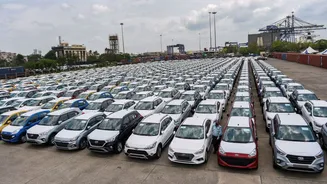Automobile Sector's Growth
The automotive industry showed robust performance in October. Several major players recorded substantial sales increases. Tata Motors witnessed a surge
of 26.6% in sales, and Mahindra & Mahindra experienced a similar rise of 26%. Furthermore, Ashok Leyland saw sales go up by 16%, while Maruti Suzuki increased by 7%. Meanwhile, Honda Cars India sales climbed by 15.3%, and Toyota enjoyed a significant surge of 39%. Kia India sales jumped by 30%, and TVS Motor saw an 11% increase. Nissan India sold 9,675 units last month. These figures reflect an overall positive trend in consumer demand and market confidence within the automotive segment. This boom suggests resilience and recovery across the sector.
Financial Performance Variations
October's financial results reveal a wide spectrum of outcomes across different companies. GHCL reported a 32% drop in Q2 profits due to lower sales. Netweb Technologies, however, saw its Q2 profit increase by 19.8% to reach Rs 31.4 crore. Mahindra Lifespace's Q2 profit stood at Rs 47.91 crore, and Phoenix Mills reported a 39% rise in Q2 profit, totaling Rs 304 crore. In contrast, Tata Chemicals experienced a 60% dip in Q2 profit, settling at Rs 77 crore. Bank of Baroda's Q2 profit decreased by 8%. These diverse financial performances highlight the varied economic climates individual businesses encounter. These fluctuations underscore the importance of understanding the microeconomic factors influencing profitability.
Power, Production Trends
The month also saw shifts in production and consumption. Power consumption dipped by 6% in October, reaching 132 billion units, which indicated a potential slowdown in industrial activity or a shift in energy use. Coal India's production faced a drop during October. These indicators provide a snapshot of the energy sector's health. The trend underscores the link between economic activity and resource utilization. These changes signal potential areas of focus for policymakers and stakeholders involved in energy planning and industrial output.
Infrastructure, Development Projects
Several infrastructural projects and development initiatives made headlines. Titagarh Rail secured a Mumbai Metro order worth Rs 2,481 crore. UP RERA approved 15 new projects, valued at ₹2,434 crore. Additionally, Dharan Infra-EPC and Skymax finalized a deal worth Rs 215 crore. These projects highlight the continuous investment in infrastructure across different regions of India. Such initiatives not only foster economic growth but also improve connectivity and living standards, reflecting government commitment to comprehensive development and economic prosperity. These developments support job creation and urban development.
Market, Investment Dynamics
Key movements in the financial markets and investment activities occurred. Pine Labs initiated its IPO launch on November 7, aiming to raise Rs 2,080 crore through a fresh issue. Shadowfax filed for an IPO, targeting a fresh issue of Rs 2,000 crore. Also, Sebi penalized 20 for manipulating Quasar India share prices. GST collections in October rose, reaching Rs 1.96 lakh crore, signaling strong tax revenue for the government. These activities reveal the prevailing investor sentiment and financial market dynamics. These initiatives showcase the ongoing investment interests and government efforts to encourage transparency within the market.
Other Economic Indicators
Several other developments marked the economic scene. Exports for Pakistan's textile industry surged to a 3-year high. Rs 5,817 crore in Rs 2000 notes remained in circulation. The DGCA amended wheelchair norms for airports. Goa's tourist arrivals were up 6%, and international inflow increased. The RBI Board reviewed the economy in Udaipur. Furthermore, GST registration in 3 days was introduced for small businesses. These miscellaneous indicators provide a comprehensive picture of the broader economic environment and business conditions. Such aspects of the economy reflect various facets of consumer behavior and policy implementation.














